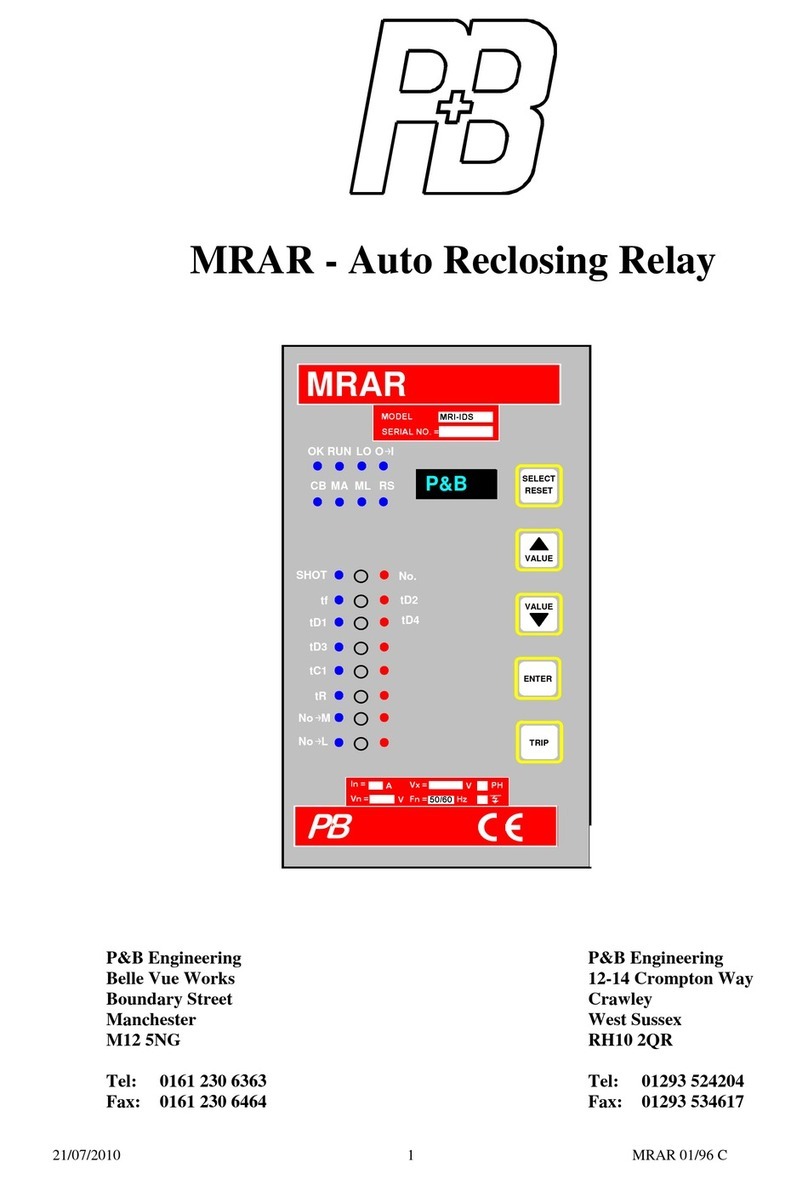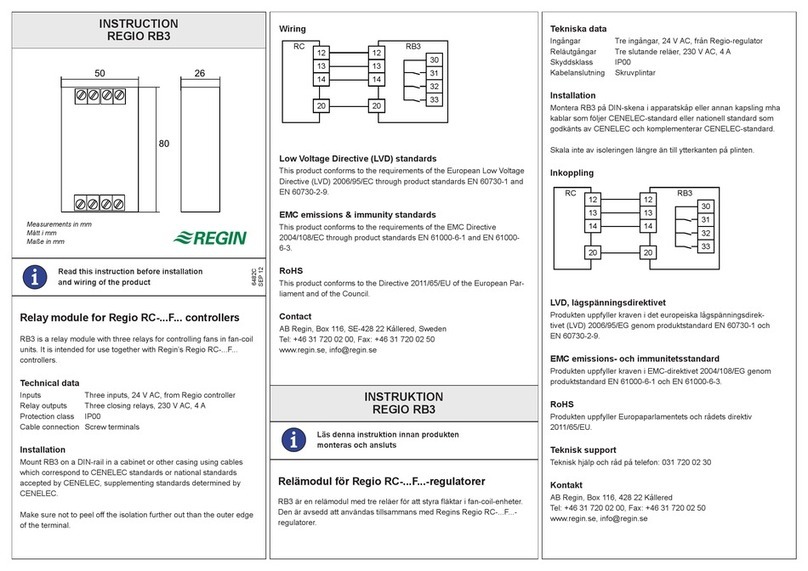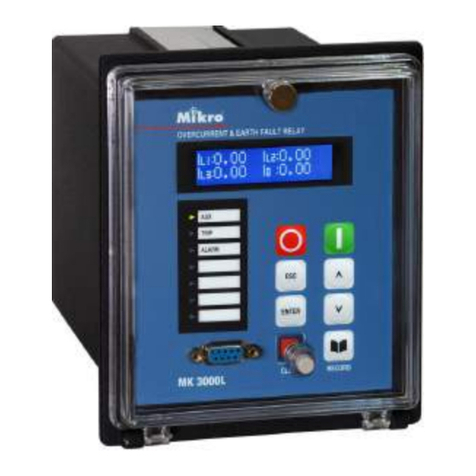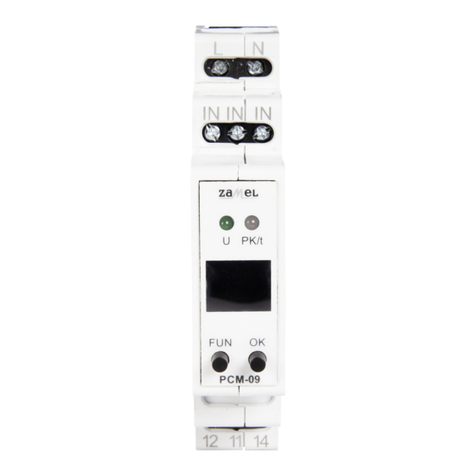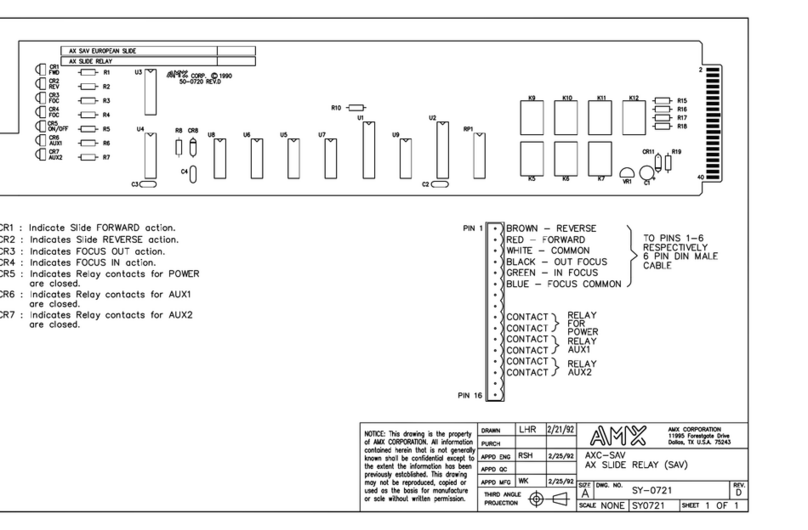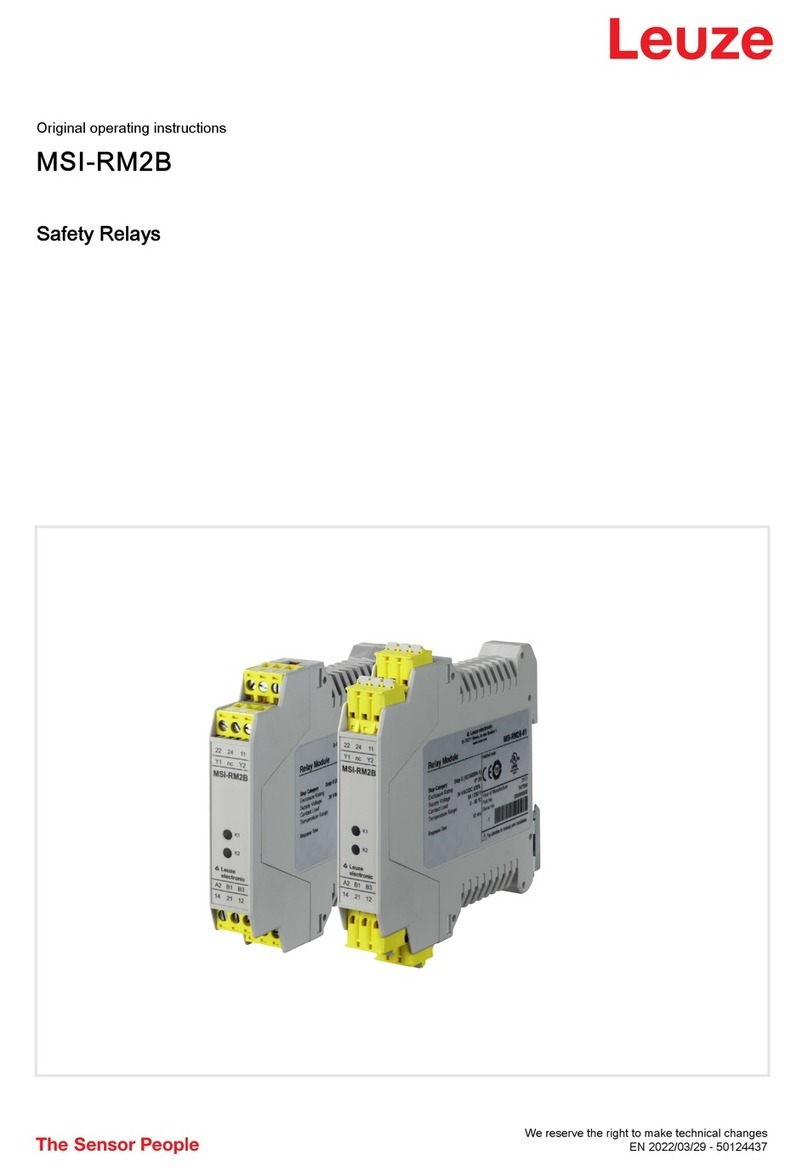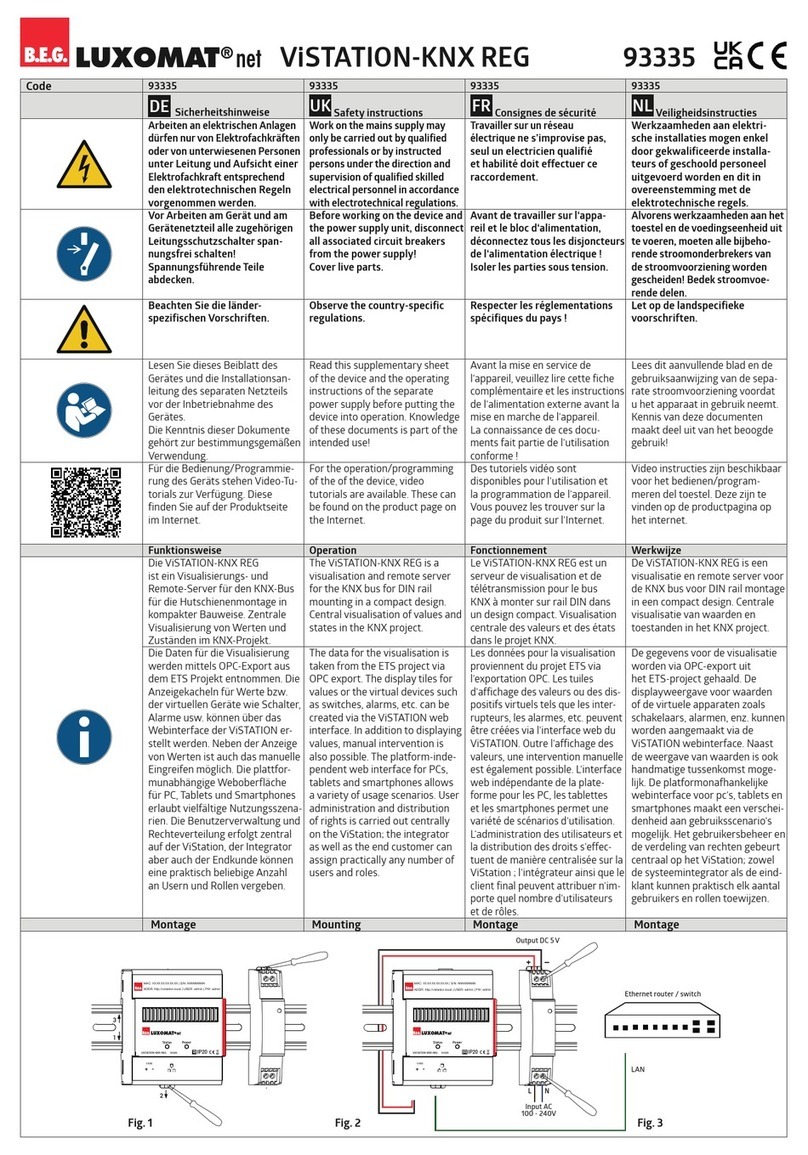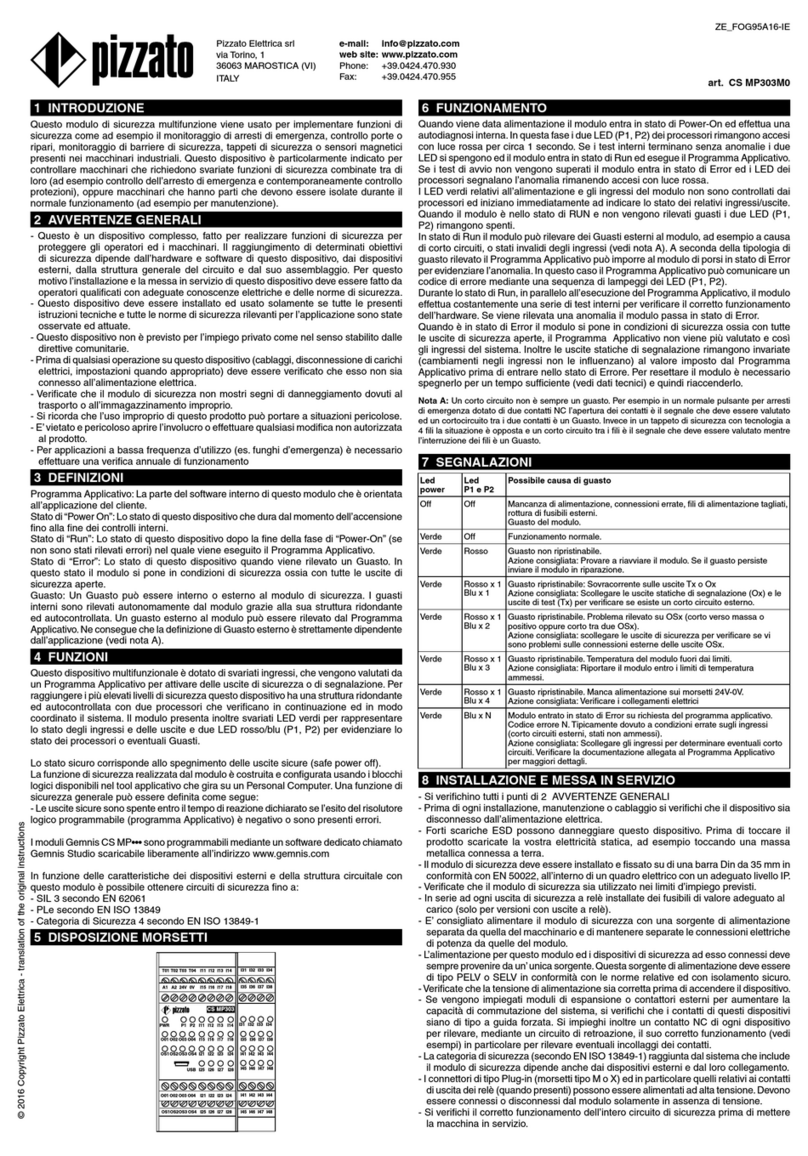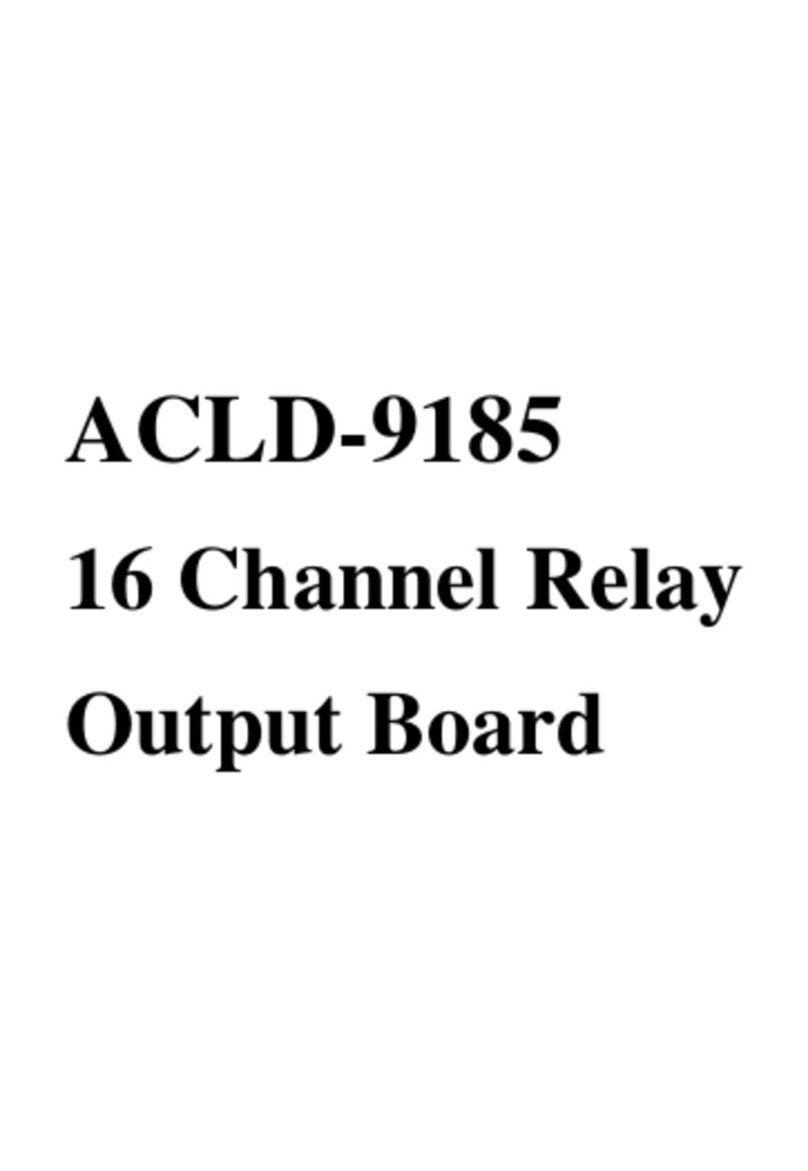P&B MPR3E5 User manual

Issue H
MPR 3E5
Digital Motor Protection Relay
P&B Engineering
Belle Vue Works
Boundary Street
Manchester
M12 5NG
Tel: 0161 230 6363

Issue H
Fax:0161 230 6464
Contents
CONTENTS ..................................................................................................................................................................... I
1. INTRODUCTION...................................................................................................................................................... 2
2. APPLICATION.......................................................................................................................................................... 3
3. FEATURES AND CHARACTERISTICS ............................................................................................................... 3
4. DESIGN ...................................................................................................................................................................... 4
4.1 CIRCUIT DIAGRAMS ................................................................................................................................................ 4
4.1.1 Analogue input circuits................................................................................................................................... 5
4.1.2 Output relays................................................................................................................................................... 5
4.1.3Remote data communication............................................................................................................................ 5
5. FRONT PANEL......................................................................................................................................................... 6
5.1 ALPHANUMERIC DISPLAY ....................................................................................................................................... 6
5.1.2. Mode 2 Settings.............................................................................................................................................. 8
5.1.3. Fault indication ............................................................................................................................................. 9
5.2. LED indicators.................................................................................................................................................. 9
5.3. Push buttons...................................................................................................................................................... 9
6. WORKING PRINCIPLES...................................................................................................................................... 10
6.1 ANALOGUE CIRCUITS ............................................................................................................................................ 10
6.2 DIGITAL CIRCUITS ................................................................................................................................................. 10
7. OPERATION AND SETTING ............................................................................................................................... 11
7.1 LAYOUT OF THE CONTROL ELEMENTS ................................................................................................................... 11
7.2. RELAY DISPLAY AND SETTING PROCEDURE......................................................................................................... 11
7.2.1. Display mode(1)........................................................................................................................................... 11
7.2.2. Setting Mode (2)........................................................................................................................................... 11
7.3 SETTING PROCEDURE ............................................................................................................................................ 13
7.3.1. t6x Setting .................................................................................................................................................... 13
7.3.2. Speed Switch ................................................................................................................................................ 13
7.3.3. Full Load Current Setting I FLC ................................................................................................................ 13
7.3.4. CT Primary Setting ...................................................................................................................................... 13
7.3.5. Hot/Cold Ratio Setting................................................................................................................................. 14
7.3.6. Thermal Overload Pre-Alarm Setting.......................................................................................................... 14
7.3.7. Number of Starts per Hour. ......................................................................................................................... 14
7.3.8. Start Inhibit Time......................................................................................................................................... 14
7.3.9. Earth Fault Current ..................................................................................................................................... 14
7.3.10. Earth Fault trip Time................................................................................................................................. 15
7.3.11. Unbalance Current .................................................................................................................................... 15
7.3.12. Undercurrent Setting ................................................................................................................................. 16
7.3.13. Undercurrent Time..................................................................................................................................... 16
7.3.14. High Set Overcurrent................................................................................................................................. 16
7.3.15. High Set Overcurrent Time........................................................................................................................ 16
7.3.16 Low Set Overcurrent ................................................................................................................................... 16
7.3.17 Low Set Overcurrent Time .......................................................................................................................... 16
7.3.19 Set Password............................................................................................................................................... 16
7.3.20 Serial Link Address, RSnn........................................................................................................................... 16

Issue H
7.4 MATRIX SETTING .................................................................................................................................................. 17
7.4.1 Trip Relay Matrix, Tnnn ............................................................................................................................... 17
7.4.2 Programmable Relay Matrix, Pnnn.............................................................................................................. 17
7.4.3 Alarm Relay Matrix, Annn ............................................................................................................................ 18
7.4.4 Earth fault parameters Matrix, Ennn............................................................................................................ 18
7.4.5 Trip/ Reset Matrix, Rnnn.............................................................................................................................. 19
7.4.6 Thermal O/L Matrix, Cnnn ......................................................................................................................... 19
7.4.7 Speed switch Matrix, Snnn........................................................................................................................... 20
7.4.8 Advanced relay Matrix, Xnnn ....................................................................................................................... 20
7.5. DIP SWITCH SETTINGS......................................................................................................................................... 22
7.6. TEST TRIP ............................................................................................................................................................ 23
7.7. RESET .................................................................................................................................................................. 23
7.7.1 Hand reset..................................................................................................................................................... 23
7.7.2 Auto-reset at Power Up ................................................................................................................................ 23
7.8. PHASE ROTATION................................................................................................................................................. 23
7.9. SETTING VALUE CALCULATION............................................................................................................................. 23
8. RELAY CASE.......................................................................................................................................................... 24
8.1 INDIVIDUAL CASE.................................................................................................................................................. 24
8.2 RACK MOUNTING .................................................................................................................................................. 24
8.3 TERMINAL CONNECTIONS...................................................................................................................................... 24
9. COMMISSIONING AND TESTING THE MPR3E5........................................................................................... 24
9.1. COMMISSIONING. ................................................................................................................................................. 24
9.2. TESTING............................................................................................................................................................... 25
10. TECHNICAL DATA ............................................................................................................................................. 28
10.1 MEASURING INPUT CIRCUITS .............................................................................................................................. 28
10.2 AUXILIARY POWER SUPPLY ................................................................................................................................. 28
10.3 COMMON DATA................................................................................................................................................... 28
10.4 TOLERANCES .................................................................................................................................................. 29
10.6 OUTPUT CONTACT RATINGS ................................................................................................................................ 31
10.7 SYSTEM DATA ..................................................................................................................................................... 31
10.8 HOUSING............................................................................................................................................................. 32
10.9 CONNECTION DETAILS ........................................................................................................................................ 33
11. ORDER FORM...................................................................................................................................................... 34

14/1/98 Page 2 Issue H
1. Introduction
The application of powerful microprocessors opens a new chapter for power system protective
relaying. The digital processing of measured values and the ability to perform complex arithmetic
and logic operations, give digital protection relays significant performance and flexibility
improvements over their traditional analogue counterparts. Additional advantages - very small power
consumption, adaptability, self-supervision, fault diagnosis through fault data recording, smaller
physical construction and selectable relay characteristics - all combine to allow the implementation
of accurate and highly reliable protection schemes at a significantly reduced financial burden.
The development of microprocessor based protective relays and their introduction into the market
has been stimulated by the recent trend to replace analogue with digital equipment. This modern
trend has prompted the development of a new P&B protective relay family - the MR relay series.
This comprehensive family of protection relays can satisfy the demands of even the most complex
protection schemes:
MRI - Overcurrent Relay (Independent time/I.D.M.T + earth + directional facilities)
MRI-V - Voltage Dependent Overcurrent Relay
MREF - Restricted Earth Fault Relay
MRMF - Mains Failure Relay
MRNS - Negative Sequence Relay
MRRP - Power Relay
MRCS - Check Synchronising Relay
MRFF - Field Failure Relay
The superiority of digital protective relaying over traditional analogue devices, as embodied by the
MR relay family, is summarised by the following features:
•
••
•Integration of many protective functions in a single compact case
•
••
•High accuracy owing to digital processing
•
••
•Digital relay setting with very wide setting ranges and fine setting steps
•
••
•Comfortable setting procedure through extensive human - relay dialogue
•
••
•Measured values and fault data indication by means of alpha-numeric display
•
••
•Data exchange with DCS/SCADA by means of RS485
•
••
•Operational reliability through self-supervision
A similar but simplified range, with reduced functions and without display, is also available. The
MIRI - overcurrent and earth fault relays, and the MIRV - undervoltage, overvoltage and neutral
voltage displacement relays. To complement the MR series, a range of Auxiliary, Timing and
Tripping devices are also available.
The MPR range of motor protection relays embodies the developments in technology of the MRI,
and MIRI as well as previous electronic motor protection relays, with the traditional knowledge and
expertise developed over the long tradition of motor protection within P & B Engineering.

14/1/98 Page 3 Issue H
2. Application
The MPR 3E5 is a universal digital adjustable motor protection relay. It serves as overload,
overcurrent, negative sequence (unbalance), and general protection for synchronous and induction
machines. With a large selection of adjustment possibilities, the MPR 3E5 is suitable for almost any
type of machine.
The protective functions of the MPR 3E5 are summarised as follows:
•Thermal Overload protection with adjustable current/time curves and selectable hot/cold
ratios.
•Overload Pre-Alarm with a separate output relay.
•Low Set and High Set Overcurrent Protection
•Single Phasing Protection
•Start Limiter
•Earth/Ground Fault Protection.
•Unbalance (Negative Phase Sequence) protection.
•Incorrect Phase Rotation protection.
•Undercurrent Protection (Definite Time).
•Stall protection using a speed switch input.
•Fully Programmable Output Relay operation.
•Fault trip inhibit setting for Contactor Applications.
3. Features and characteristics
•Complete digital processing of the sampled measured values
•Digital filtering of measured values using discrete Fourier analysis to suppress
high frequency harmonics and D.C. component induced by faults or system
operations
•Self adjusting sample frequency for operation between 40 - 70Hz.
•Extremely wide setting ranges with fine setting steps
•Unauthorised user access control through password protection
•User defined password
•Continuous self-supervision of software and hardware
•Outstanding design flexibility for easy selection of appropriate operational scheme
for numerous applications
•Numerical display of setting values, actual measured values and memorised fault data etc.
•Setting, Measured and Fault Parameters available via RS485 serial link.
•Wide voltage range for DC or AC power supply
•Withdrawable modules with automatic short circuit of C.T. inputs

14/1/98 Page 4 Issue H
4. Design
4.1 Circuit Diagrams
18
POWER
SUPPLY
1 2 CASE
Supply
MPR 3E5
Typical Earthing Shown
TRIP SIGNAL 7
5
3
6
4
8
10
14
12
+
17
15
16
Gnd
-
9
13
11
PROGRAMMABLE
ALARM
RS485
21
22
23
24
25
26
27
28
L1
L2
L3
I1
I2
I3
IE
S2
P2
P1
S1
CHASSIS
EARTH
19
20
SPEED SWITCH
IE
27
28
CBCT
Alternative E/F connection
for CBT
Rstab
Fig 1 Connection Diagram for use with 3 line CT’s and alternative core balance CT.
18
POWER
SUPPLY
1 2 CASE
Supply
MPR 3E5
Typical Earthing Shown
7
5
3
6
4
8
10
14
12
+
171516
Gnd
-
9
13
11
RS485
21
22
23
24
25
26
27
28
L1
L2
L3
I1
I2
I3
IE
S2
P2
P1
S1
CHASSIS
EARTH
19
20
SPEED SWITCH
CBCT
Note: Core Balance CT must
be provided if earth fault
protection is required
TRIP SIGNAL
PROGRAMMABLE
ALARM
Fig 2 Special connection diagram when relay used with two line CT’s.

14/1/98 Page 5 Issue H
4.1.1 Analogue input circuits
The constantly monitored measuring values are galvanically decoupled, filtered and finally fed to the
analogue/digital converter. The protection unit receives these analogue input signals of the phase
currents I1, I2, I3 and Earth fault Ie, via separate input transformers.
4.1.2 Output relays
The MPR 3E5 has three output relays, with single or dual pole change-over contacts as detailed in
the previous diagram and summarised below:
•Tripping relay (2)
•Alarm relay (1)
•Programmable Relay (1)
4.1.3Remote data communication
The MPR 3E5 is provided with an RS485 interface for remote data communication with a control
centre. This facility provides the following information:
•Status signals
•Self supervision alarm signal
•Actual measured values
•Relay settings
•Fault signalling

14/1/98 Page 6 Issue H
5. Front panel
The front panel of the MPR 3E5 comprises the following operation and indication elements:
•Alphanumeric display (4 Digits)
•5 push buttons for setting and other operations
•20 LEDs for measured value indication and
setting
5.1 Alphanumeric Display
The measured and set values, and recorded fault data, are shown alphanumerically on the display.
The meaning of the displayed values is easily interpreted from the LED indicators on the front panel.
Because of the large adjustment possibilities the data on the MPR3E5 is split into a number of
related groups
Mode 1 Display. This shows the analogue values being read by the Relay. It is accessible by
pressing the <SELECT/RESET> Button. It then cycles through the analogue values.
Mode 2 Setting. This shows the parameters that have been set on the relay. This is accessed
when the correct password is entered when "P&B" is displayed on the screen. Then to cycle through
the setting parameters press the <SELECT/RESET> button.
Fault Indication. This indicates the current fault on the relay. When the relay trips a
Mnemonic appears on the 4 digit display, indicating the current fault.

14/1/98 Page 7 Issue H
5.1.1. Mode 1 Display.
The following subset of parameters are available for viewing and are accessed using the
<SELECT/RESET> push-button in a cyclic manner. Pressing for longer than 1 second returns to the
start of the cycle. Parameters available are either actual real-time running values or memorised
values as follows:
Data Displayed (ALL CURRENTS
IN PRIMARY AMPS)
LED's Illuminated
P&B (Relay Manufacturer)
Actual line current L1 L1 (Green)
Actual line current L2 L2 (Green)
Actual line current L3 L3 (Green)
Actual Earth Fault Current E (Green)
Stored Max Starting Current L1 * L1 (Green - Red-Alternating)
Stored Max Starting Current L2 * L2 (Green - Red-Alternating)
Stored Max Starting Current L3 * L3 (Green - Red-Alternating)
Earth Fault Current * E (Green - Flashing)
Actual Load Current (%) * L1, L2 & L3 (Green)
Actual Thermal Capacity (%) L1, L2 & L3 (Green - Flashing)
Actual Unbalance (%)* I2
Total Number of Starts OPS/HR (Green)
Total Hours Run OPS/HR (Green - Flashing)
Latest Start Time in seconds ST (Green)
Relay Address For Communications RS (Green)
t6x Setting 1 (Green)
Full Load Current (I FLC) 1 (Green - Flashing)
Table 1 - Display mode (1)
In addition to the above, when the motor is starting the S/R LED indicates Green-Flashing and when
the motor is running the S/R LED indicates Green-Steady. The value of motor load is held after a trip
and updated when the next start is detected. Total hours run is the total time the relay has detected a
running motor. When the kA illuminates the display value is multiplied by 1000, e.g. to read line
current in kA or hours run in 1000’s of hours.
* FOLLOWING A RELAY TRIP THIS VALUE IS THE STORED PRE-TRIP FAULT VALUE. TO
RESET THE RELAY FOLLOWING A TRIP AND CANCEL THE STORED TRIP
VALUES,(EXCEPT THE STORED MAX/STARTING CURRENT L1, L2 AND L3) PRESS THE
<SELECT/RESET> BUTTON FOR MORE THAN 3 SECONDS, OR RE-START THE MOTOR.

14/1/98 Page 8 Issue H
5.1.2. Mode 2 Settings.
The setting parameters may be changed in mode 2.
Data Displayed LED No/ Colour
t6x Setting 1/ Green
Full Load Current I FLC 1/ Green - Flashing
CT Primary Setting In 9/ Green - Flashing
Hot / Cold Ratio 9/ Green
Thermal O/L Pre-Alarm 1/ Green/Orange -Alternating
E/Fault Current, %In 2/ Green
Earth Fault Time 2/ Green - Flashing
NPS Current, %FLC 3/ Green
Low Set O/C, %FLC 4/ Green
Low Set O/C Time 4/ Green - Flashing
High Set O/C, %In 5/ Green
High Set O/C Time 5/ Green - Flashing
Undercurrent, %FLC 6/ Green
Undercurrent Time 6/ Green - Flashing
Number of Starts/hr 7/ Green
Start Inhibit Time 7/ Green - Flashing
Set Password 8/ Green
Serial Link Address 8/Rsnn on display
Set Trip Relay Action Tnnn on Display
Set Program. Relay Pnnn on Display
Set Alarm Relay Action Annn on Display
Set E/Fault Parameters Ennn on Display
Set Trip Reset Action Rnnn on Display
Set Thermal O/L Curve Cnnn on Display
Set Speed Switch Snnn on Display
Advanced Relay 1. Xnnn on Display
More detail on these parameter are available in the Setting Section.

14/1/98 Page 9 Issue H
5.1.3. Fault indication
When the relay has tripped, the display will show "TRIP" and the relevant LED will be illuminated
red. On cycling through the displays in Mode 1, a four letter mnemonic describing the trip will be
displayed. The mnemonics are listed in the table below.
Trip Mnemonic
Overload OVLD
Earth Fault EFLT
High Set Overcurrent HSOC
Low Set Overcurrent LSOC
Unbalance NPSC
Undercurrent UCUR
Too Many Starts STLM
Phase Reversal ROTN
Stalled STLD
Single Phasing SPHA
Should an internal fault occur causing the relay to alarm, then the mnemonic "IRF" followed by a
number will be displayed. If this occurs, or any other indication such as "UDEF" then the
indication/number should be noted and reported to the P&B Engineering office ( +44 161 230 6363).
5.2. LED indicators
The LEDs to the left of the display indicate measuring or tripping values. The purpose of the
corresponding LED is identified by the adjacent inscription.
The first row of four LEDs to the left of the display are tri-coloured, green and yellow indicate
measuring and red indicates a fault condition.
The LED marked RS indicates active serial data communication.
The rest of the LEDs are used when accessing Mode 1 and Mode 2 of the Display.
5.3. Push buttons
The front panel contains five push buttons used for setting, measuring and other user functions.
The individual setting and measuring values can be selected in turn by pressing the <SELECT> /
<RESET> push button. This button also resets the relay if pressed for approximately 3 seconds.
The <UP> and <DOWN> push buttons are for incrementing and decrementing any selected
parameter. Continuous pressing of these push buttons will cause the parameter to change at an
increased rate.
The <ENTER> push button is used to transfer the indicated value to the internal parameter memory.
An unintended or unauthorised change of the selected parameter can be avoided through the
password protection facility.
The <TRIP> push button is used to test the output relay circuits, both for tripping and signalling.
This operation is also password protected.

14/1/98 Page 10 Issue H
6. Working principles
6.1 Analogue circuits
The incoming currents and voltages from the external transformers are converted to internal signals
in proportion to the current and voltage, via the internal input transducers and shunt resistors. The
noise signals caused by inductive and capacitive coupling are suppressed by an analogue RC filter
circuit. The analogue signals are fed to the A/D converter of the micro-processor and transformed to
digital signals through sample-hold circuits. The analogue signals are sampled at a rate of 16 times
the system frequency (40 - 70Hz), giving a sample time of 1.56 - 0.9mS for each measured value.
6.2 Digital circuits
The essential component of the MPR 3E5 relay is a powerful micro-controller. All of the operations,
from the analogue digital conversion to the relay trip decision, are carried out by the micro-controller
digitally. The relay program, located in EPROM, allows the CPU of the micro-controller to calculate
the reactance values in order to detect a possible fault.
For the calculation of the current values, an efficient digital filter, based on the Fourier Analysis
(DFFT - Discrete Fast Fourier Transformation), is applied to suppress high frequency harmonics and
DC components caused by fault induced transients or other system disturbances. The actual
calculated values are compared with the relay settings. When a value exceeds the starting value the
unit starts the corresponding time delay calculation. When the set time delay has elapsed, a trip
signal is given.
The relay setting values for all parameters are stored in EEPROM, so that the actual relay settings
cannot be lost, even in the event of auxiliary supply interruption. The micro-processor is supervised
through a built in "Watch-dog" timer. Should a failure occur the watch-dog timer resets the micro-
processor and gives an alarm signal via the self supervision output relay.

14/1/98 Page 11 Issue H
7. Operation and Setting
7.1 Layout of the control elements
All control elements required for the operation and adjustment of the MPR 3E5 are located on the
front panel. They are divided according to function into the three following groups:
•Alphanumeric Display: Indication of parameter set values, actual measured
values and recorded fault data.
•LED's: Indication of selected parameters and measured quantities.
•Push Buttons: Selection of parameter to be adjusted, quantity to be measured
and adjustment of parameter values. Where;
<SELECT / RESET> Selection of the parameter to be set and the relay quantities to
be measured. Press for 3 seconds to reset.
<UP> Increment of the setting values for the parameter selected.
<DOWN> Decrement of the setting values for the parameter selected.
<ENTER> Storage of the setting values for the selected parameter.
<TRIP> Testing of the output relay circuits.
With the front cover in place, it is only possible to press the <SELECT/RESET>
push button. this allows display of parameters or a relay reset following a trip. Should the cover be
opened, the <UP>, <DOWN>, <ENTER> and <TRIP> , buttons are inactive and it is not possible
to alter the protection settings without putting the relay into the setting mode(2), which requires entry
of a password. By pressing the <SELECT/RESET> push button, it is possible to step through the
parameters. The corresponding LED illuminates, and the measured or present set value of the
selected parameter is indicated on the display. This set value may then be increased or decreased by
pressing the <UP> or <DOWN> buttons respectively. The selected set value is only stored after
pressing the <ENTER> push button and inputting the correct password. This means that adjustment
of the unit is only possible by authorised users. In addition by pressing the button for 3 seconds or
more the relay may be reset after a trip, providing the thermal capacity has reduced to a value
sufficient to enable a restart.
7.2. Relay Display and Setting Procedure.
7.2.1. Display mode(1)
In this subset of parameters the data is for viewing and are accessed using the <SELECT/RESET>
push-button in a cyclic manner. Pressing for longer than 1 second returns to the start of the cycle.
7.2.2. Setting Mode (2)
In order to enter this mode the user must be in display mode (1), by use of the <SELECT/RESET>
Push button move through the indications until “P&B” is shown on the display, then enter the correct
password ( default “∧
∧∧
∧∧
∧∧
∧∧
∧∧
∧∧
∧∧
∧“). When the password is entered correctly, the display shows “∂∂∂∂“ with
the accents flashing to confirm relay is in setting mode. In order to change the setting in mode(2),
cycle through the setting parameters by pressing the <SELECT/RESET> button until the required
parameter is reached. Then increase or decrease the setting by using the <^ VALUE> or <∨
∨∨
∨
VALUE> buttons followed by <ENTER> to store the new value. To return quickly to the start of
the cycle i.e. the t6x setting, press the <SELECT/RESET> key for longer than 1 second. To return

14/1/98 Page 12 Issue H
to mode (1) the user may press <TRIP>, followed by <SELECT/RESET> or alternatively wait for
the automatic return which occurs after approximately 2 minutes of inactivity on the push buttons.
The setting parameters may be changed in mode (2) using the procedure detailed above, the
parameters are detailed in table 2:
Data Displayed LED No/ Colour Parameter Range Step Default
t6x Setting 1/ Green 1-120 sec 1 sec 10 secs
Full Load Current
I FLC
1/ Green - Flashing 0.5 to 1.25 times CT
Primary Amps
0.01 CT
Primary
Amp
CT Primary Setting In 9/ Green - Flashing 0.5-9.5A
10-2500A
0.5A
5A
1A or 5A
(In) *
Hot / Cold Ratio 9/ Green 20-80% 10% 50%
Thermal O/L Pre-
Alarm
1/ Green/Orange -
Alternating
50-99% & OFF 1% 90%
E/Fault Current, %In 2/ Green 5-40% & OFF 1% OFF
Earth Fault Time 2/ Green - Flashing 0.0 -- 1.0 Second 0.1 sec 0.1 sec
NPS Current, %FLC 3/ Green 15%, 30%, & OFF OFF
Low Set O/C, %FLC 4/ Green 200%,300%,400%, & OFF OFF
Low Set O/C Time 4/ Green - Flashing 0.5 -- 5.0 secs 0.5 sec 0.5 sec
High Set O/C, %In 5/ Green 200 - 1200% of In & OFF 50% OFF
High Set O/C Time 5/ Green - Flashing 0.0 -- 1.0 Second 0.1 sec 0.1 sec
Undercurrent, %FLC 6/ Green 20 -- 95% & OFF 5% OFF
Undercurrent Time 6/ Green - Flashing 1-120 seconds 1 sec 30 secs
Number of Starts/hr 7/ Green 1-20 & OFF 1 OFF
Start Inhibit Time 7/ Green - Flashing 1-60 Minutes 1 Min 10 Mins
Set Password 8/ Green Any 4 Characters ⇑⇑⇑⇑
Serial Link Address 8/Rsnn on display 01-32 & OFF 1 OFF
Set Trip Relay Action Tnnn on Display 000-255 (see Matrix) 255
Set Program. Relay Pnnn on Display 000-255 (see Matrix) 254
Set Alarm Relay
Action
Annn on Display 000-255 (see Matrix) 255
Set E/Fault Parameters
Ennn on Display 000 or 129 to-255 (see
Matrix)
0
Set Trip Reset Action Rnnn on Display 000-255 (see Matrix) 0
Set Thermal O/L
Curve
Cnnn on Display 001-255 (see Matrix) 8
Set Speed Switch Snnn on Display 0-255 (see Matrix) 0
Advanced Relay 1. Xnnn on Display 003-140 (see Matrix) 3
* Note: the factory setting for a 1A rated relay is as for a CT ratio 1/1
and for a 5A rated relay 5/5
If Selected
Table 2 - Setting mode (2)

14/1/98 Page 13 Issue H
7.3 Setting procedure
In the following sections the setting of all relay parameters is described in detail:
7.3.1. t6x Setting
This setting specifies the time the relay will take to trip at 6 times FLC, with respect to the cold
characteristic curve, and therefore determines the basic thermal characteristic.
7.3.2. Speed Switch
When this function is enabled (see speed switch matrix, Snnn) the relay operation times are
decreased as a function of the percentage setting selected, if the motor becomes stalled when starting
or running. The speed switch should be connected such that when the speed falls (stall situation) a
switch opens and disconnects an auxiliary voltage at the terminals shown in Figs 1 and 2. This is
regarded as a fail safe connection. The auxiliary voltage can be the same as the relay power supply
or any other source within the same range.
7.3.2.1. A Starting Stall
Note that the action of the speed switch is ignored for the first period of a start determined by half the
t6x setting in seconds. After this, should a starting stall develop, the remainder of the trip time is
carried out at a reduced time according to the setting of the Snnn matrix. The actual total trip time tss
for a stall during starting for which the normal trip time would be tcold is given by:
Where t6x=Relay Setting
S=25%, 50% or 75% according to the matrix Snnn.
7.3.2.2. A Running Stall
If the motor has started normally, has been running and then develops a stall, the trip time trs is given
by
Where thot is the normal hot curve trip time.
7.3.3. Full Load Current Setting I FLC
Note that the CT primary setting(see below) MUST BE SET FIRST.
This setting corresponds to the normal running full load current of the machine, set in primary
amps. This setting is limited to the range 0.5 - 1. 25 x CT rating.
7.3.4. CT Primary Setting
This setting, should be set equal to the line CT rating in primary amps.
1002
6
2
6S
x
xt
t
xt
tcoldss
−+=
100
S
xtt hotrs =

14/1/98 Page 14 Issue H
7.3.5. Hot/Cold Ratio Setting
This setting should correspond to the amount of available thermal capacity for a motor running at
FLC in the Hot condition. This is set as a percentage of thermal capacity available in the cold
condition which is always 100%.
When the motor has been running for some time at full load current, the displayed value of Thermal
capacity will reach a steady state value SSTC%. This value depends on the HOT/COLD ratio setting
H/C% and corresponding values are given by the table below:-
H/C % SSTC% - ±1% Amount Of Thermal
Capacity Available ±1%
20 69 31
30 61 39
40 52 48
50 44 56
60 35 65
70 26 74
80 17 83
Table 3 - Steady State Thermal Capacities.
7.3.6. Thermal Overload Pre-Alarm Setting
When the running current exceeds the overload level, the thermal capacity will increase. When this
reaches the Thermal Pre-Alarm level, the output alarm Relay will operate.
7.3.7. Number of Starts per Hour.
The number of starts per hour the motor will make can be limited by the MPR3E5. The starting
energy is integrated on a time-basis separately from the thermal overload model. This parameter can
also be set to off in which case the number of starts is unlimited.
7.3.7.1. Start Time Detection
The start condition is detected as a rise in current from under 0.1 times to over 1.5 times IN. The start
time is calculated as the time from the rise to the average of the 3 line currents dropping to below
1.25 x IN.
Additionally, if auxiliary power is restored to the relay with more than approx 10% full load current
flowing then the relay assumes the running mode. This permits the relay to be unplugged and
plugged while on-line.
7.3.8. Start Inhibit Time
This sets the minimum time that must elapse before the motor can be restarted after previously
exceeding the pre-set number of starts. The total reset time can be longer than the setting because it
may include the integrated starts energy delay before the inhibit time delay is enabled.
7.3.9. Earth Fault Current
This setting specifies the pickup level of Earth Fault Current as a percentage of the Earth Fault relay
rating In.

14/1/98 Page 15 Issue H
7.3.10. Earth Fault trip Time
This setting determines the trip time following the measured earth fault current exceeding the pickup
value. A setting of 0.0 indicates instantaneous operation, i.e. 30 - 50mS at twice times setting.
7.3.11. Unbalance Current
This setting determines the pick-up level of the unbalance Current as a percentage of FLC before a
Trip occurs. This is based on the difference between the maximum and minimum measured line
currents and the following formula:-
a) For Line currents above 25% FLC to 100% FLC (The unbalance feature is inhibited below 25%
FLC):-
b) Between 1xFLC and 2.5xFLC
c) Above 2.5xFLC
A setting of OFF here will disable the feature. The relay measures the difference in magnitude
between the maximum and minimum line currents as a percentage of the maximum. The equivalent
apparent negative phase sequence component is then displayed.
The time characteristics are shown in the graph below.
%100% minmax x
I
II
Unbalance
FLC
−
=
%100%
max
minmax x
I
II
Unbalance
−
=
%100% minmax x
I
II
Unbalance
FLC
−
=

14/1/98 Page 16 Issue H
7.3.12. Undercurrent Setting
This setting determines the pickup upon an undercurrent, this is generally used to protect against an
unloaded machine, e.g. Drive belt failure. A setting of OFF here will disable the feature.
7.3.13. Undercurrent Time
This sets a time between the unit registering an undercurrent level and the actual tripping of the unit.
7.3.14. High Set Overcurrent
This feature is normally enabled when the motor is being controlled by a circuit breaker allowing a
much quicker trip time for high fault currents. A setting of OFF here will disable the feature, it is
recommended that this feature is disabled for fused contactors.
7.3.15. High Set Overcurrent Time
This setting determines the trip time following the measured current exceeding the pickup value.
Note: The High set overcurrent setting is DOUBLED during starting. This feature allows more
sensitive short circuit protection on circuit breaker controlled motors whilst avoiding trips due to the
asymmetrical transient portion of the starting current.
7.3.16 Low Set Overcurrent
This feature allows a quicker trip time for fault currents, or overloads of a medium magnitude. A
setting of OFF here will disable the feature
7.3.17 Low Set Overcurrent Time
This setting determines the trip time following the measured current exceeding the pickup value.
NOTE: The Low set feature is not in service during starting. This feature can therefore be used to
provide a quick operating definite time stall protection once the motor is running.
7.3.19 Set Password
This allows the user to password protect the Relay to avoid unauthorised changing of parameters.
Any four of the pushbuttons may be selected in any order. After pressing <ENTER> the new
password is saved. If you intend to change from the default password, please a make a careful note of
the new password. If you forget the new password, consult your local agent or P&B Engineering for
help on how to restore the default password.
7.3.20 Serial Link Address, RSnn
This setting in the range of 1 to 32 or “OFF” identifies the MPR 3E5 unit to the communications
hardware on the RS485 Data Highway.

14/1/98 Page 17 Issue H
7.4 Matrix Setting
7.4.1 Trip Relay Matrix, Tnnn
This setting, range 000 to 255, sets the faults that are to operate the trip output relay. The setting also
allows the Trip Relay to be either energised or de-energised upon activating.
A Thermal Overload trip will always operate i.e. Change the state of, the Trip Relay. To configure
the relay, a brief example is shown below:
Example
Only Overload Trip, Earth Fault Trip and Low Set Trip are required and the relay is to energise upon
tripping. Therefore the set value would be: 161
Action Numerical
Value
Set
Y/N
Value
Earth Fault Trip 128 Y 128
High Set Trip 64
Low Set Trip 32 Y 32
NPS Trip 16
Number of Starts Trip 8
Undercurrent Trip 4
Phase Rotation 2
Relay Energises on TRIP 1 Y 1
161
By default the Trip matrix is set to 255, i.e. all trips enabled, energise on trip.
7.4.2 Programmable Relay Matrix, Pnnn
This setting, range 000 to 255, sets the faults that will cause the Programmable Relay to be energised
as well as acting upon commands from the Serial Link
Example
Only Earth Fault and Low Set are required to be acted upon, therefore the set value would be: 160
Action Numerical
Value
Set
Y/N
Value
Earth Fault Alarm 128 Y 128
High Set Alarm 64
Low Set Alarm 32 Y 32
NPS Alarm 16
Number of Starts Alarm 8
Undercurrent Alarm 4
Phase Rotation Alarm 2
Activate Upon Serial Link
Commands
1
160
If Serial Link is selected then none of the bits have any effect. Also unlike the Trip Relay, the
Programmable Relay does not automatically pick-up for Thermal Overload.

14/1/98 Page 18 Issue H
7.4.3 Alarm Relay Matrix, Annn
This setting range, 000 to 255, sets the faults that will cause the Alarm Relay to be either energised
or de-energised upon activating.
Example
Only Thermal Pre-Alarm, Earth Fault Alarm and Low Set Alarm are required and the relay is to de-
energise upon Alarm. Therefore the set value would be: 161
Action Numerical
Value
Set
Y/N
Value
Earth Fault Alarm 128 Y 128
High Set Alarm 64
Low Set Alarm 32 Y 32
NPS Alarm 16
Number of Starts Alarm 8
Undercurrent Alarm 4
Phase Rotation Alarm 2
Relay De-energises on
Alarm
1 Y 1
161
A Thermal Pre-Alarm will always operate i.e. Change the state of, the Alarm Relay.
7.4.4 Earth fault parameters Matrix, Ennn
This setting, range 000 or 129 to 255, sets the Earth Fault source (Core Balance or Residual
connection), and if Core Balance the Primary Rating of the Core Balance CT. It is assumed that the
core balance secondary CT rated current is always 1A.
Example 1-Core balance CT(CBCT):
To configure the relay such that operation is via a Core Balance CT with a primary rating of 1500A,
then the value set would be: 203
If the exact primary rating cannot be selected, for example 50A, then select the next highest standard
above this e.g. 60A. The required primary earth fault setting can then be obtained within the earth
fault parameter range.
Action Numerical
Value
Set
Y/N
Value
Core Balance CT 128 Y 128
1280 64 Y 64
640 32
320 16
160 8 Y 8
80 4
40 2 Y 2
20 1 Y 1
This manual suits for next models
1
Table of contents
Other P&B Relay manuals
